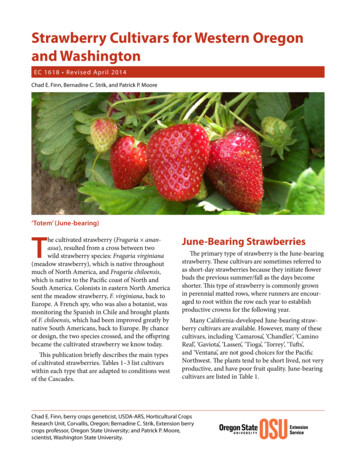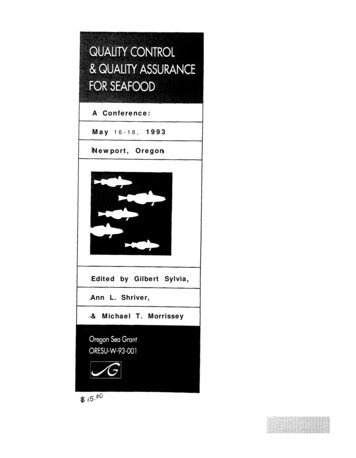
Transcription
Strawberry Cultivars for Western Oregonand WashingtonE C 1618 R e vised Apr il 2014Chad E. Finn, Bernadine C. Strik, and Patrick P. Moore‘Totem’ (June-bearing)The cultivated strawberry (Fragaria ananassa), resulted from a cross between twowild strawberry species: Fragaria virginiana(meadow strawberry), which is native throughoutmuch of North America, and Fragaria chiloensis,which is native to the Pacific coast of North andSouth America. Colonists in eastern North Americasent the meadow strawberry, F. virginiana, back toEurope. A French spy, who was also a botanist, wasmonitoring the Spanish in Chile and brought plantsof F. chiloensis, which had been improved greatly bynative South Americans, back to Europe. By chanceor design, the two species crossed, and the offspringbecame the cultivated strawberry we know today.This publication briefly describes the main typesof cultivated strawberries. Tables 1–3 list cultivarswithin each type that are adapted to conditions westof the Cascades.June-Bearing StrawberriesThe primary type of strawberry is the June-bearingstrawberry. These cultivars are sometimes referred toas short-day strawberries because they initiate flowerbuds the previous summer/fall as the days becomeshorter. This type of strawberry is commonly grownin perennial matted rows, where runners are encouraged to root within the row each year to establishproductive crowns for the following year.Many California-developed June-bearing strawberry cultivars are available. However, many of thesecultivars, including ‘Camarosa’, ‘Chandler’, ‘CaminoReal’, ‘Gaviota’, ‘Lassen’, ‘Tioga’, ‘Torrey’, ‘Tufts’,and ‘Ventana’, are not good choices for the PacificNorthwest. The plants tend to be short lived, not veryproductive, and have poor fruit quality. June-bearingcultivars are listed in Table 1.Chad E. Finn, berry crops geneticist, USDA-ARS, Horticultural CropsResearch Unit, Corvallis, Oregon; Bernadine C. Strik, Extension berrycrops professor, Oregon State University; and Patrick P. Moore,scientist, Washington State University.
Everbearing StrawberriesAs people noticed that some types of strawberries bore small fall crops in addition to a springcrop, breeders and hobbyists began selecting forthis trait. The result was everbearing strawberries,such as ‘Ft. Laramie’, ‘Gem’, ‘Ogallala’, ‘Ozark Beauty’,‘Quinault’, and ‘Rockhill’. Everbearing strawberriestend to have large spring and fall crops, with littlefruit in between. An everbearing cultivar is listed inTable 2.Day-Neutral StrawberriesIn the 1970s, day-neutral (remontant) strawberries were developed at the University of California.Day-neutral strawberries flower throughout thegrowing season as long as temperatures are below90 F. Periods of hot weather will cause a temporarygap in fruit production. Day-neutral strawberriesdo not produce as many runners as the other types,so they are usually grown commercially with plasticmulch in a hill system, where runners are removed tomaintain individual plants. This type of strawberrycan be grown in annual or perennial production systems. Cultivars are listed in Table 3.‘Puget Crimson’ (top) and ‘Puget Reliance’(bottom), both June-bearingDistinguishing between everbearing andday-neutral cultivars can be confusing for the homegardener. Day-neutral cultivars are “everbearing,”whereas the old everbearing cultivars produce twodistinct crops—one in the spring and one in thefall. Furthermore, both day-neutral and everbearing cultivars are usually sold as “everbearing” inretail nurseries.Fragaria vesca (Alpine)StrawberriesFragaria vesca (fraises des bois or woods strawberry) is also commonly found throughout thenorthern hemisphere. Many “alpine strawberries”have been developed from this species. Cultivarsinclude ‘Alpine’, ‘Baron Solemacher’, and ‘Ruegen’.Plants are moderately vigorous but have poor durability because they are highly susceptible to viruses(these cultivars often are used as virus indicators).Berries are small, with a bright red external color andpale internal color. They are soft, very aromatic, andhave a mild flavor. Berries are suitable only for freshuse. Yields are low, and commercial value is limited.2‘Seascape’ (top) and ‘Albion’ (bottom),both day-neutral
Cultivar Table NotesTables 1–3 list June-bearing, everbearing, andday-neutral strawberry cultivars that are adaptedto conditions west of the Cascades. Most of thesecultivars are not adapted to colder regions in thePacific Northwest. In colder regions, choose cultivars that grow well in the Midwest or easternUnited States, including ‘Allstar’, ‘Jewel’, ‘Honeoye’,‘Earliglow’, ‘Clancy’, ‘Lateglow’, ‘Annapolis’, and‘Cavendish’ (June-bearing) or ‘Monterey’, ‘SanAndreas’, ‘Tristar’, and ‘Tribute’ (day-neutral).Not all of the listed cultivars are available innurseries.DurabilityDurability refers to how long lived a cultivarmight be in the field. Plant viruses and otherdiseases, particularly root rot, can shorten theproductive life of a planting. Some cultivars, suchas ‘Hood’, often bear for only 1 or 2 years, whereasothers, such as ‘Tillamook’, often produce for several years.Fruit Descriptions and YieldDescriptions of yield, flavor, and berry size areprimarily based on results of trials by the USDAARS/OSU cooperative breeding program at theOSU North Willamette Research and ExtensionCenter in Aurora, Oregon, and the WashingtonState University breeding program in Puyallup,Washington. If a cultivar has not been tested atthese sites, yield and berry descriptions are basedon grower experience. Yield ratings are based oncomparison to other cultivars of the same type.Fruit traits, particularly flavor, can vary tremendously based on location (because of differences intemperature and rainfall), cultural practice, and, ofcourse, personal preference.Commercial ProductionA commercial value score is provided to helpcommercial growers select appropriate cultivars forfresh and processed markets:1 Appropriate for most commercial operations2 May have commercial value but:(a) not enough is known about its performanceor(b) may meet a specific requirement(e.g., unique color or very early harvest) buthas a negative trait (e.g., low yield or poorshipping quality)3 Unlikely to have good commercial valueSmall Farm, U-Pick, and HomeGardensCultivars that are well suited to small farms,local sales, U-pick farms, and home gardens arenoted as such.What if you find a cultivar that’s noton these lists?Find out as much about it as you can: Is it June-bearing, everbearing, orday-neutral? Does the nursery’s description indicate thatit’s susceptible to any diseases, such as rootrot or viruses? What’s the fruit like?Remember: If you purchase a cultivar that is noton these lists, it probably hasn’t been extensivelytested in this region. It’s best to try a few plantsfirst and see how well they grow and how you likethe fruit.“Ease of capping” refers to how easily the fruitpick without the cap or calyx—an important traitfor processing.3
4Very earlyEarlyHoneoyeSweet SunriseMidseason Vigorous, good Medium to large size, bright red external color,durabilitypale red to red internal color, poor capping,tough skin, variable shape, fair processedquality, very good flavorMidseason Very vigorous,excellentdurabilityShuksanCharmSweet Bliss(U.S. PlantPatent pending)Midseason Vigorous,susceptible toPhytophthoracrown rotEarly toVigorous,midseason very gooddurability,tolerant toroot rotValley RedHighMediumFreshProcessedFresh orprocessedFresh orprocessed(butprocesseswell)FreshHigh toProcessedvery highMediumMedium to large size, bright red internal andMediumexternal color, beautiful and glossy, symmetrical to highconic shape, tough skin, excellent flavorMedium size, bright red internal and externalcolor, excellent capping, tender skin, excellentprocessed quality, very good flavorFreshMarketHigh toFresh orvery high processedLow tomediumYieldLarge, consistent size from first to last pick, deep Highred external color, medium red internal color,very uniform, attractive shape, good firmnessbut tender skin, good processed quality,good flavorLarge to very large size, bright red external color,pale red to red internal color, glossy, attractive,good firmness but tender skin, uniform shape,good processed quality, good flavorEarly toVigorous,midseason very gooddurability(U.S. PlantPatent 9,310)Medium to large size, bright red internal andexternal color, easy capping, medium firmness,uneven shape, good processed quality,excellent flavorPuget RelianceVigorous, poordurability,sensitive tovirusesMedium to large size, bright red and glossyexternal color, deep red internal color, goodcapping, uniform shape, excellent flavor andprocessed qualityMedium to large size, bright red and glossyexternal color, pale red internal color, faircapping, firm, uniform conic shape, poorprocessed quality, good flavorFruitEarlyVigorous,durableVigorous, poordurability, verysusceptible toroot rotPlantHood(U.S. PlantPatent pending)SeasonCultivarThese cultivars have a large spring (May–July) crop and are listed in approximate order of ripening.Table 1. June-bearing strawberry cultivars (Table continues)(too new to fully evaluate)2(too new to fully evaluate)2(variable market satisfaction,from fair to excellent)2(too new to fully evaluate)2(some resistance by buyers inprocessed markets so confirmwith buyer; very attractive forlocal fresh sales)1(despite name recognition andoutstanding quality, lack ofdurability is a real concern; forprocessed market, have contractin place before planting)2(too new to fully evaluate)2(very early fresh-market niche)2Large-scalecommercial valueSmallfarm orhomegarden
5Midseason Very vigorous,to lateexcellentdurabilityMidseason Vigorous, good Medium to large size, bright red internal andto latedurabilityexternal color, poor capping, fair firmness,excellent quality, excellent flavorVery lateBentonRainierPuget CrimsonPlantModerate vigor, poorto fair durabilityCultivarQuinaultThis cultivar has a large spring and fall crop.Medium size, bright red externaland internal color, very soft, faircapping, fair flavorFruitLow tomediumYieldFirst berries very large but size drops quickly,red external and internal color, fair capping,good firmness, uniform shape, excellent flavorMedium size, bright red external color, paleinternal color, caps well, medium to firm,tender skin, poor frozen color and texture,excellent flavorTable 2. Everbearing strawberry cultivar (two crops per year)VigorousMidseason ModeratevigorSequoia(U.S. PlantPatent 22,781)Midseason Vigorous, good Medium to large size, bright red externaldurabilityand internal color, caps well, good firmness,tender skin, excellent processed quality, verygood flavorTotemMarketMediumto highFreshMarketMediumto highMediumMediumto high13 (homegardenonly) Smallfarm orhomegarden (but day-neutral cultivarsperform better)Small farm or home garden(local fresh)2(local fresh)2311Large-scalecommercial valueLarge-scalecommercial valueFreshFreshFreshFreshProcessedHigh toFresh orvery high processedYieldCan have large, dark red fruit with productionMediumextending over a longer season than most Junebearing cultivarsMidseason ModerateLarge to very large size, bright red externalvigor, excellent color, red internal color, caps well, very firm,durabilitymoderately tough skin, very good processedquality, good flavor but bland if not fully ripeFruitTillamookPlantSeasonCultivarThese cultivars have a large spring (May–July) crop and are listed in approximate order of ripening.Table 1. June-bearing strawberry cultivars
6Fair vigor, poordurabilityAlbionLow vigor, poordurabilityMontereyVigorous, fair togood durabilityModerate vigor,good durability,susceptible toverticillium wiltTributeSeascape(U.S. PlantPatent 7,614)Vigorous, fair togood durabilityTristar(U.S. PlantPatent 19,975)San Andreas(U.S. PlantPatent 19,767)Low vigor, poordurabilityLow vigor, poordurability(U.S. PlantPatent 8,517)Mara des Bois(U.S. PlantPatent 16,228)PlantCultivarLarge, bright red externalcolor, pale internal color, poorcapping, firm, good flavorMedium size, attractive, glossybright red external color,bright red internal color, poorcapping, very good flavorVery small to medium size,glossy bright red externalcolor, bright red internal color,good firmness, excellent flavorLarge size, firm, light externaland internal color, bland,susceptible to anthracnoseLarge size, firm, light color,mild nontraditional flavorSmall size, pale, soft, uniqueflavor that people either loveor dislikeLarge size, light red externalcolor, pale internal color, firm,good flavorFruitLow tomediumLowLowLow tomediumLow tomediumLowMediumto highYieldFreshFreshFreshFreshFreshFreshFresh(best fruit quality combined withsize among day-neutral cultivars inthe Pacific Northwest)23(too small on average)3223(in plasticulture system)1Market Large-scale commercial value Smallfarm orhomegardenYield low to mediumunless managedintensively, but best fruitquality of the day-neutralcultivarsSee comment above forTristar.Tribute and Tristar areoften compared. Tristarhas better flavor; Tributehas good flavor but betterfruit size.Common day-neutralcultivar in northernCaliforniaCommon day-neutralcultivar in northernCaliforniaCommonly promoted ingarden literature but hasnot done well in our trialsMost important dayneutral cultivar innorthern California andthe Pacific NorthwestCommentThese cultivars have a large spring crop followed by a constant but small number of fruit until frost. Plants stop flowering for a while when temperatures exceed90 F. Cultivars are listed in approximate order of ripening.Table 3. Day-neutral strawberry cultivars (continuous cropping)
‘Sweet Bliss’ (June-bearing)‘Charm’ (June-bearing)‘Rainier’ (June-bearing)‘Hood’ (June-bearing)7
For More InformationGrowing Strawberries in Your Home Garden(EC 1307). Oregon State University Growing Day-Neutral Strawberries in WesternWashington (FS132E). Washington StateUniversity Extension. http://pubs.wsu.edu/‘Tillamook’ (June-bearing)‘Sweet Sunrise’ (June-bearing)‘Shuksan’ (June-bearing)Cultivar photo credits:Albion, Puget Reliance, Seascape, Shuksan, Tillamook, Totem: Bernadine C. Strik, Oregon State University.Charm, Hood, Sweet Sunrise: Chad E. Finn, USDA-ARS, used with permission.Puget Crimson: Patrick P. Moore, Washington State University, used with permission.Rainier: Tom Baumann, Expert Agriculture Team Ltd, Canada, used with permission.Sweet Bliss: Chaim Kempler, Berries and More Consulting, used with permission.Trade-name products and services are mentioned as illustrations only. This does not mean that the Oregon State University Extension Service either endorsesthese products and services or intends to discriminate against products and services not mentioned. 2014 Oregon State University. Extension work is a cooperative program of Oregon State University, the U.S. Department of Agriculture, and Oregon counties.Oregon State University Extension Service offers educational programs, activities, and materials without discrimination based on age, color, disability, genderidentity or expression, genetic information, marital status, national origin, race, religion, sex, sexual orientation, or veteran’s status. Oregon State UniversityExtension Service is an Equal Opportunity Employer.Published March 2008. Revised April 2014.8
6 Table 3. Day-neutral strawberry cultivars (continuous cropping) These cultivars have a large spring crop followed by a constant but small number of fruit until frost. Plants stop flowering for a while when temperatures exceed 90 F. Cultivars are listed in approximate order of ripening.










